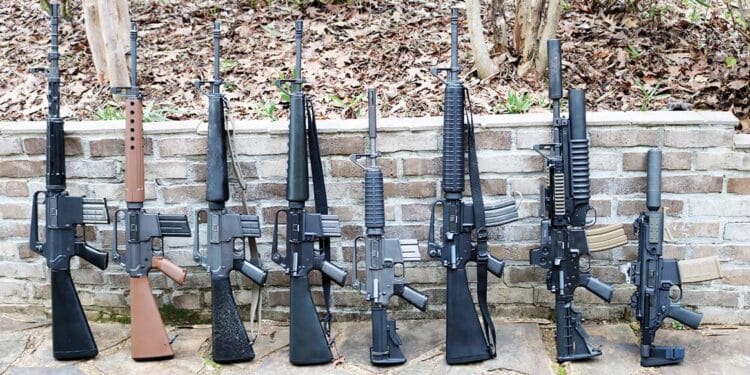Story & Photography by Will Dabbs, M.D.
There are certain mechanical contrivances that have fundamentally shaped the human experience. Born in 1836, an English businessman and plumber named Thomas Crapper ultimately held nine patents, three of which governed the function of the ubiquitous water closet. He developed the U-bend trap used in every flush toilet on the planet today. Crapper also supplied the sanitary fixtures for King Edward VIII’s abode at Sandringham House in Norfolk, becoming, in essence, the man responsible for managing the royal poop. In 1910, the guy whose name inspired countless sophomoric epithets died, appropriately enough, of colon cancer.
In 1899, Johan Vaaler, a Norwegian inventor who held degrees in mathematics, science and electronics, patented the humble paperclip. The sheer volume of printed treatises kept orderly by this pedestrian device boggles the mind. Kleenex tissue was sold originally in 1924 as a cold cream remover and disposable handkerchief. In 1973, John Mitchell and Martin Cooper demonstrated the world’s first cell phone, a massive device weighing some 4.4 pounds.
Each of these inventions changed the way people interacted with their world. If we were to apply these same discriminating criteria to the genre of firearms there are several that might make the cut. Comrade Kalashnikov’s mechanical monster certainly shaped the planet’s geopolitical landscape. John Moses Browning’s timeless 1911 made an undeniable splash as well. On this side of the pond, however, it is the AR-15 that really dominates that conversation today.

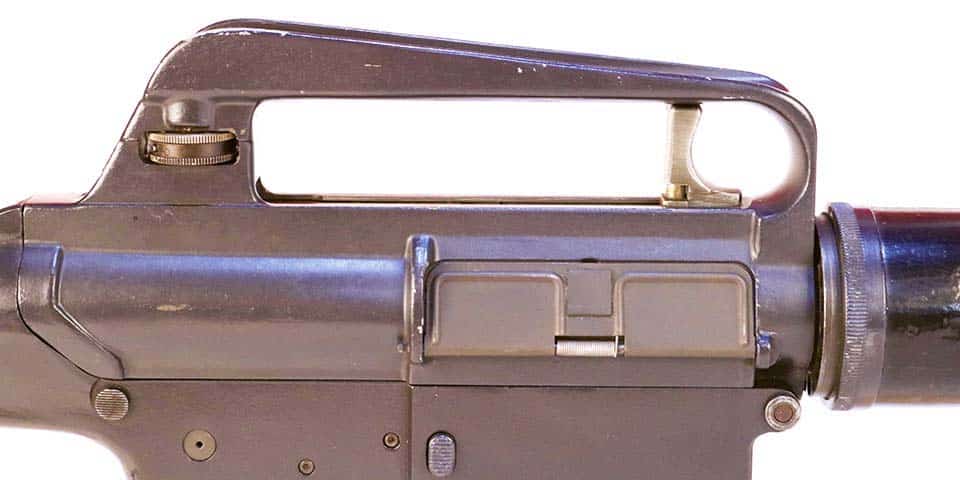
Origin Story
The tale of the most radically advanced firearm of the modern era begins, appropriately enough, at the end of World War II. The American Infantry company of late WWII sported no less than six different firearms and three different cartridges issued in five different configurations. Faced with this undeniable logistical nightmare, military planners set out to contrive a single firearm to replace the rifle, carbine, submachine gun and squad automatic weapon. Just as a camel is a horse designed by a committee, the end result didn’t really leave anyone fully satisfied.
The resulting M14 was and is a remarkably effective weapon in its own right. Elegant, reliable and beautiful in a martial sort of way, this holy amalgam of Parkerized steel and deep-stained American walnut sets my heart aflutter even today. However, anyone who has ever executed a 15-mile forced march or tried to clear a cluttered building appreciates that a weapon that is 44 inches long and weighs 9.2 pounds empty gets burdensome fast. Now hold that thought.
Ultimately destined to address this sticky conundrum, in 1954 George Sullivan formed a tiny little company called ArmaLite in a leased machine shop on Santa Monica Boulevard in Hollywood, California. ArmaLite was never intended to mass produce firearms. Sullivan envisioned his little subsidiary of the Fairchild Engine and Airplane Corporation as a mechanical think tank of sorts. Their first creation was the AR-1 Parasniper, a novel weapon that used a foam-filled polymer stock and a composite aluminum barrel with a steel liner. AR stands for ArmaLite Rifle, a designation that has endured to the present day.
While testing some of his creations at a local range, George Sullivan bumped into a young Marine recently back from the South Pacific named Gene Stoner. Impressed by the young man’s mechanical acumen, Sullivan hired him on the spot as ArmaLite’s chief design engineer. By 1956 ArmaLite sported a grand total of nine employees, but they had big ideas.
World War II saw an explosion in the fields of engineering and materials science. Aviation, in particular, pushed the use of lightweight alloys and radical polymers to produce flying machines that delivered countless tons of destruction on enemy cities and kiss the edge of space. Stoner and Sullivan planned to take these radical aerospace materials and use them to build new and unconventional small arms.
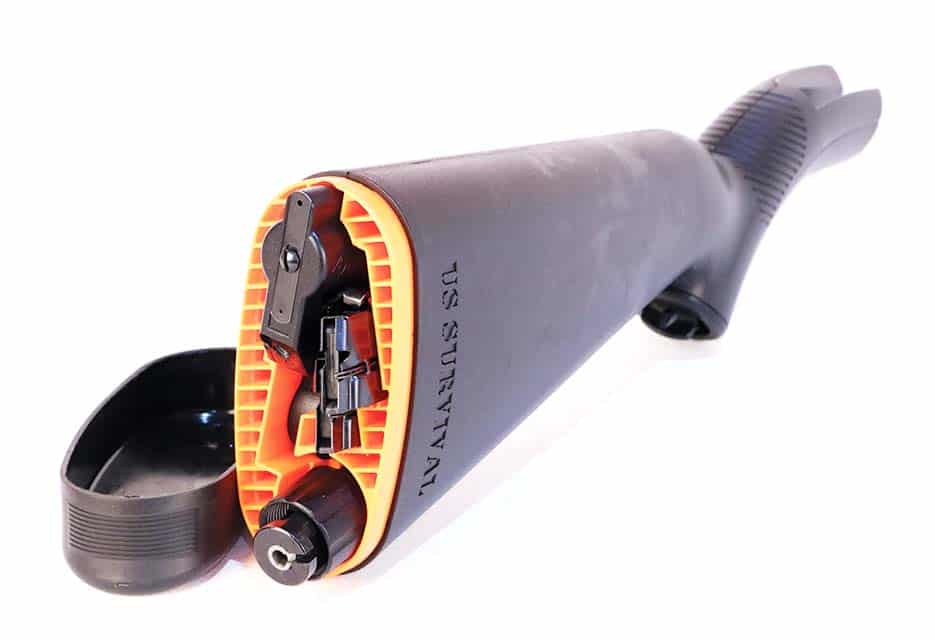

The Theory of Evolution by Natural Selection
ArmaLite, like most ably-helmed startups, focused initially on low-hanging fruit. Their AR-5 fired the .22 Hornet cartridge and was eventually adopted by the U.S. Air Force as the MA-1 Survival Rifle. The subsequent AR-7 was chambered for .22LR and marketed for civilian shooters.
The AR-7 sported a radical takedown design wherein the barrel, receiver and magazines could be stored within the gun’s polymer stock. The rifle would even float. The Israelis used a few operationally as aircrew survival weapons, and James Bond brought down a SPECTRE helicopter wielding an AR-7 in “From Russia with Love.” Henry Repeating Arms offers this basic gun as the U.S. Survival Rifle today.
The AR-10: ArmaLite’s First Battle Rifle
In 1955 and 1956, ArmaLite focused on the AR-10. The 7.62x51mm AR-10 was their first effort at designing a serious combat implement. Powered by a novel, lightweight, direct gas impingement operating system, the AR-10 called into question most everything about conventional gun design.
Two hand-built versions tepidly entered the competition that ultimately led to the aforementioned M14, but an unfortunate catastrophic barrel failure during testing left the AR-10 on the sidelines. In 1957, however, ArmaLite sold a 5-year production license for the AR-10 to the Dutch firm Artillerie-Inrichtingen (AI).
AI AR-10 rifles can be fractionated into three discrete models. The “Sudanese” version stems from a lot of 2,500 copies sold to the government of, you guessed it, Sudan. The “Transitional” versions incorporated lessons learned in combat operations with the Sudanese variants. The “Portuguese” sort was the definitive Dutch variant used in combat by Portuguese Special Forces, particularly in their variegated operations in Africa.
This Portuguese AR-10 took on many of the attributes we see in our ubiquitous black rifles today. The charging handle was a trigger-like appendage located within the gun’s iconic carrying handle, but the pistol grip, bolt release, magazine catch and safety/selector were all in their familiar spots. When combined with advanced polymer furniture and lightweight aluminum receivers, the AR-10 raised the bar for human engineering in small arms.

Scaling Everything Down
By the late 1950s, revenue from the full-figured AR-10 was disappointing, so ArmaLite engineers Gene Stoner, Bob Fremont and Jim Sullivan focused their efforts on a smaller caliber version of the basic AR-10 action intended to compete for the USAF’s new rifle contract. Chambered for Stoner’s radical 5.56x45mm high-velocity cartridge, the resulting AR-15 took the company and the gun down an exciting new path. That path, however, was not without its potholes.
In 1958, ArmaLite submitted 10 AR-15s along with 100 25-round box magazines to the U.S. Army for testing. These early rifles retained the trigger-style charging handle of the Portuguese AR-10 along with the larger gun’s basic morphology. The AR-15 performed well in testing, but General Maxwell Taylor, of WWII Airborne fame, ultimately vetoed the AR-15 in favor of the larger, heavier M14.
By 1959, ArmaLite was losing money, and the basic business model was being called into question. In frustration ArmaLite sold the rights to both the AR-10 and AR-15 to Colt, a company with much more extensive production facilities and institutional gun manufacturing experience. Now divested of these two designs, the ArmaLite crew launched in an entirely different direction. This endeavor ultimately produced the AR-18 and AR-180 family of rifles. This basic action went on to drive such stalwarts as the Steyr AUG, the HK416, the British SA80 and the Israeli Tavor combat rifles, but that is a tale for another time.
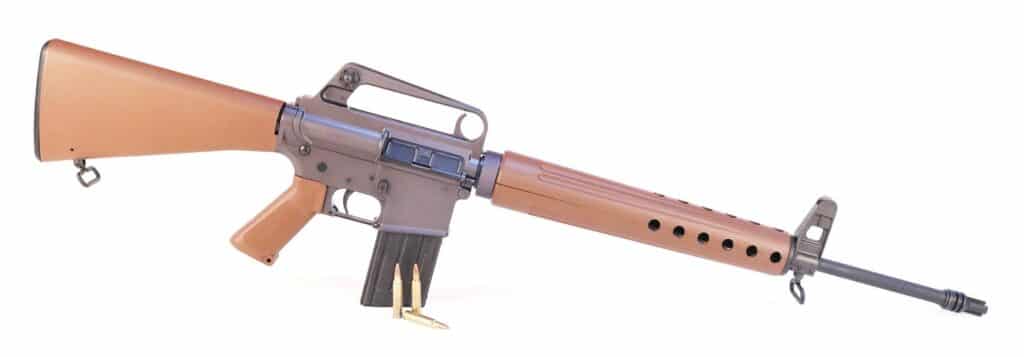
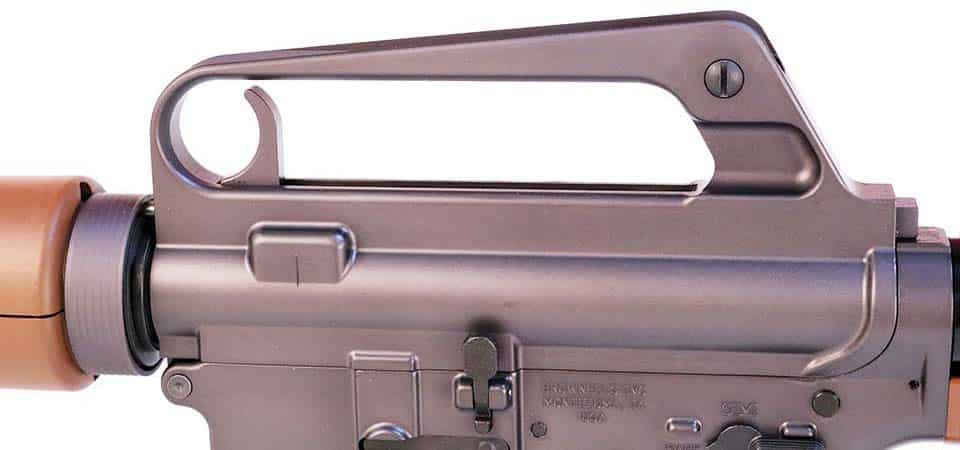
The Colt Dynasty
Colt took the basic AR-15 design and streamlined everything for mass production. Colt relocated the charging handle to the rear of the receiver and rebranded the rifle as the Colt ArmaLite AR-15 Model 01. After a marketing tour of Southeast Asia, Colt sold its first military versions of the rifle to Malaysia in September 1959.
In the summer of 1960 Air Force General Curtis LeMay ordered 8,500 of the lithe little guns after enjoying an informal demonstration of the rifle on a friend’s farm. Internecine conflicts between the services and individual officers drove the purchase of the radical new weapon in fits and starts, but 10 of the rifles eventually made it to Vietnam in 1961 for limited use by Special Forces personnel.
SF operators were thrilled with the lightweight weapon’s fast handling and the devastating downrange effects of the gun’s high-velocity, small-caliber rounds. These early rifles sported barrels with a 1-in-14 twist. Subsequent tubes pushed that rate to 1-in-12 starting in 1964.
In 1963, the AR-15 morphed into the “Rifle, Caliber 5.56mm, M16,” and the Army went all in on the revolutionary little weapon. This rifle featured black polymer triangular handguards, an open three-pronged flash suppressor and no forward assist. After some well-documented function problems that stemmed from poor maintenance and the precipitous adoption of ball powder not originally intended for use with the weapon, the M16A1, the ultimate evolution of the Vietnam-era M16, developed into a mature and reliable combat implement.


There Is Ever Room for Improvement
The M16A1 saw service with U.S. and Allied troops around the globe, eventually cementing its reputation for reliability and effectiveness despite its rocky start in Southeast Asia. However, by 1983 it was time for an upgrade. Championed by the U.S. Marine Corps, the improved M16A2 was the ultimate result.
The M16A2 was about a pound heavier than the previous M16A1 and sported a buttstock some 5/8-inch longer. The barrel had a heavier profile from the front sight base forward but retained the slimmer geometry on the near end so as to accept existing M203 grenade launchers. The bottom slots were eliminated from the birdcage flash suppressor so as to minimize dust signature when firing in dirty spaces. The pistol grip got a new texturing scheme and an additional finger rest.
The two most radical changes from the M16A1 platform were in the sights and fire controls. The previous round front sight was replaced with a new version sporting a square cross section. The improved rear sight was also now easily adjustable for both elevation and windage without tools.
The fire controls on the new A2 swapped out the full-auto function for a controversial three-round burst feature. The burst limiter on the M16A2 does not automatically reset. This means that if you squeeze off a two-round burst, the next trigger squeeze will only fire a single round, allowing the limiter to reset for a subsequent three rounds. While this was intended to reduce the profligate expenditure of ammunition, today’s grunts are simply trained to use their weapons predominantly in semiauto mode.
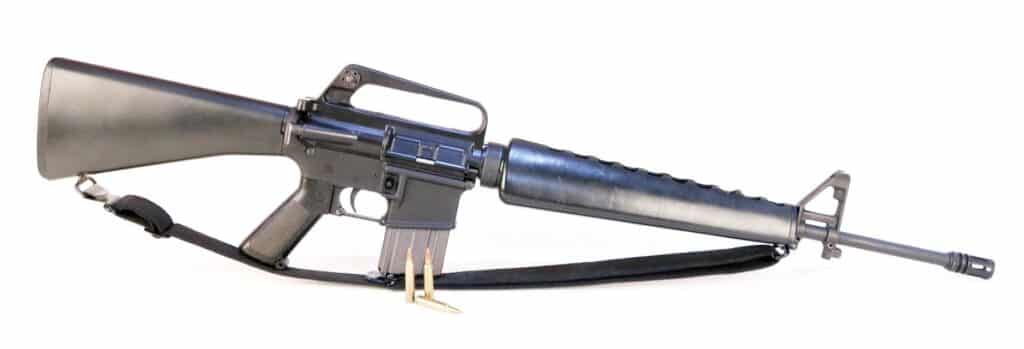
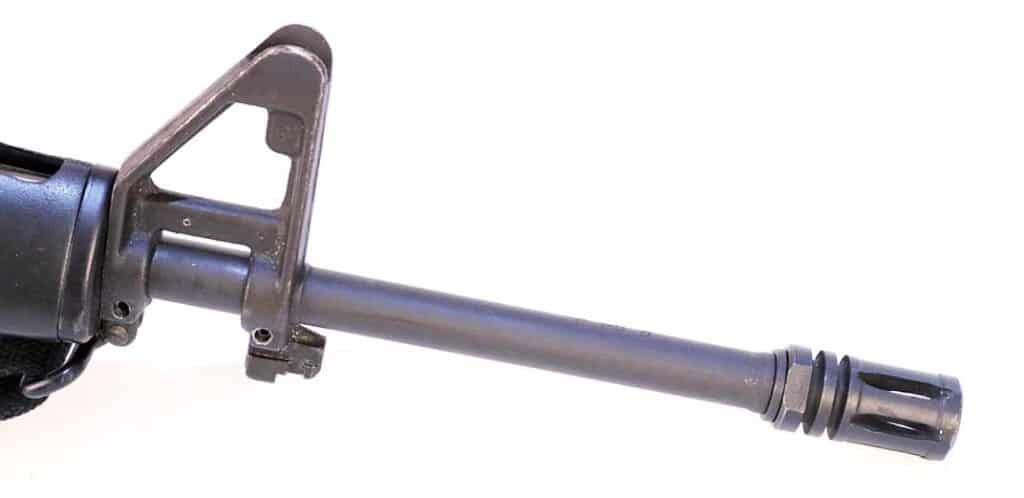
An M16 for the Information Age
In 1984, Colt began work on a new shorter version of the M16 rifle. The Vietnam-era XM177E2/CAR-15 submachine gun was used as a starting point. By melding the collapsible stock and stubby round handguards of the XM177E2 with the upper receiver and improved sights of the M16A2, Colt produced a carbine version of the M16 that struck a nice balance between portability and power. The new rifle’s 14.5-inch barrel offered decent velocities and terminal performance, particularly with the M855 62-grain loads then being adopted by the military. The new weapon was christened the M4 and first saw service with U.S. troops in Kosovo in 1999.
Now some two decades later, the M4 is the standard combat rifle across all the American armed services. The M4 includes the three-round burst limiter of the M16A2, while the M4A1 features safe, semi and full-auto settings along with a slightly heavier barrel. The addition of railed forearms and flattop upper receivers has made the M4 the most customizable firearm on the planet.
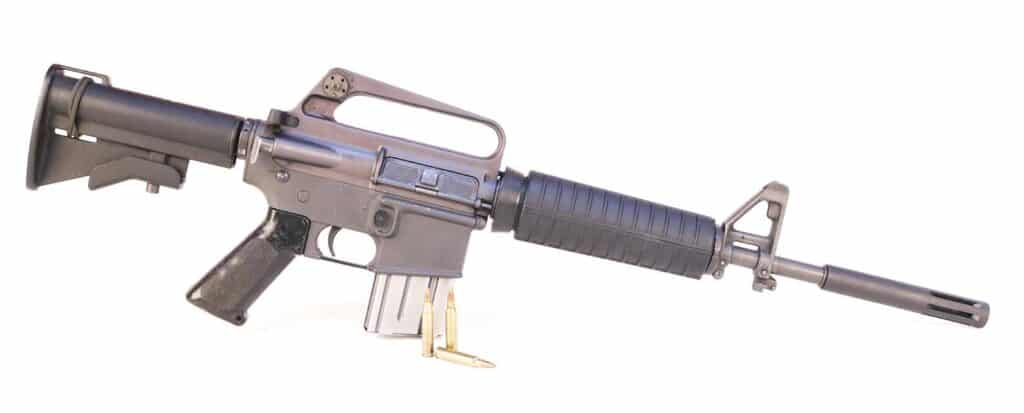
The Kleenex of Guns
It is beyond the scope of this article to outline all the labyrinthine directions the AR-15 rifle has followed in the modern era. The Marines’ M27 is an HK version powered by the short-stroke gas piston system pioneered in the AR-180. Nowadays, AR rifles span the spectrum from Lilliputian handgun versions with stubby 7.5-inch tubes all the way up to big bore sniper rigs powerful enough to take elk and moose at long ranges.
Today’s AR-15 is the most popular rifle in America. Most all gun nerds own one. Many of us own several. The advents of the Pistol Stabilizing Brace and subsequent favorable rulings by the ATF have opened up exciting new applications for Gene Stoner’s time-tested action.
The key to the AR-15’s popularity is its unrivalled modularity. By pushing out a pair of pins, the upper and lower receivers are easily separated allowing a single serialized lower to be used across a variety of platforms. Think of the AR-15 like Garanimals for gun guys.
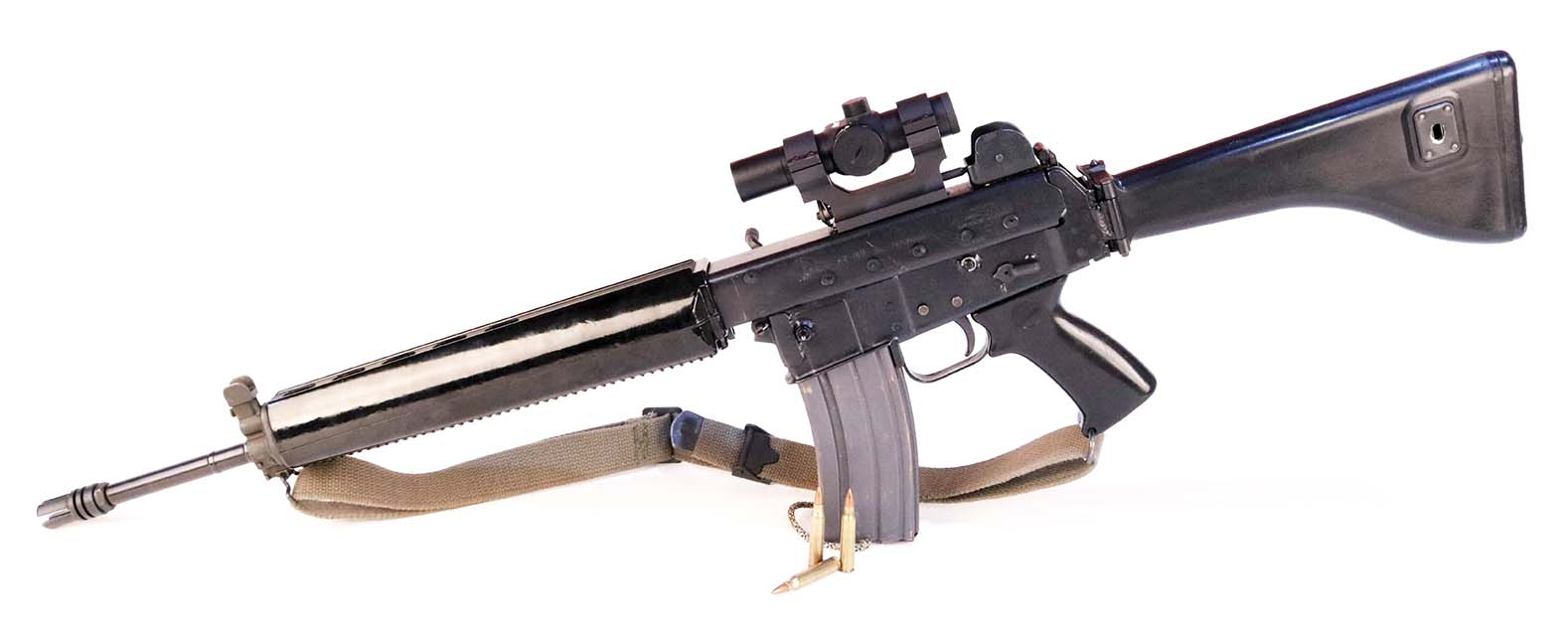
Despite several expensive efforts, Uncle Sam has been unable to find another combat rifle that is a substantive improvement over the current M4. Estimates regarding the number of AR-variant guns in American civilian hands runs into the tens of millions. Given that these receivers can now be inexpensively, easily and legally finished out at home, the exact number is simply imponderable. Legislative schemes to confiscate, restrict or further regulate the ownership of these ubiquitous guns are nothing more than pipe dreams.
Born in a tiny rented machine shop in Hollywood and fielded by militaries around the globe, the AR-15 rifle and its descendants changed the way military and law enforcement personnel did their jobs. In the hands of civilian shooters, the AR-15 has driven countless competitions, whiled away innumerable hours of recreation on the range and saved more than a few lives in real-world defensive applications. Sleek, inexpensive, capable and cool, today’s AR-15 is an integral part of modern Americana.
| This article first appeared in Small Arms Review V24N5 (May 2020) |



